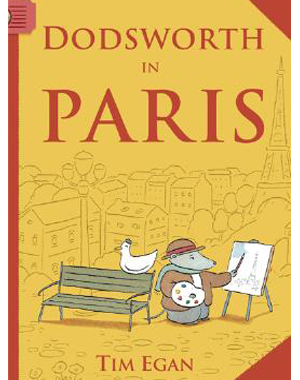Distant Feathers
Egan’s dry-as-tinder, cornball humor reverberates through his latest tale of strange doings in a small town. The setting is a quaint, half-timbered village, the citizenry all long-eared, long-snouted blue hippo-like creatures, and the protagonist is Feathers, a colossal parrot who drops in one day, literally, from space. Sedrick Van Pelt is the first to make contact with the giant bird, who has a bottomless hunger—“Bread. I love bread. Any kind of bread. Pumpernickel, rye, whole wheat, sourdough. Any kind”—as well as a stumbling, bumbling manner that reduces certain structures in the village to rubble. Baking bread and lots of it, constantly mending their battered dwellings, the townsfolk get a little tired of the admittedly good-natured Feathers. When a hurricane sweeps Feathers away, the townsfolk demonstrate a form of grief: “He had become a wonderful, if somewhat destructive, part of their lives, and they missed him very much.” In the last couple of pages, Egan (Burnt Toast on Davenport Street, 1997, etc.) turns the story on its head, all very smoothly and convincingly: He will elicit smiles from listeners. The riffs on (and great fondness for) human foibles are magnified and made poignant by the daintily lumbering residents; the little burgs of the transporting artwork are welcoming idylls.
Kirkus Reviews
Egan is known for his wild and wacky picture books, such as Metropolitan Cow (1996). His latest is no less zany. In this story, Sedrick Van Pelt is interrupted from his journal writing by the beak of a giant bird tapping at his window. The huge bird is a bread lover–” Bread. I love bread. Any kind of bread. Pumpernickel, rye, whole wheat, sourdough. Any kind. I absolutely love bread.” The rest of the story follows the efforts of Sedrick and the newly named Feathers to get that bread. First, the townspeople feed him, then they get him to work, but always disaster ensues. When a big wind blows Feathers away, the townsfolk think they’ve seen the last of the big bird, but soon enough that annoying voice is back: “Got any bread? I love bread.” The rich ink-and-watercolor art features characters and settings that are diminutive compared with the impressive red bird that is the focus of most of the pictures. The wry story has a happy ending that will satisfy kids.
Booklist


